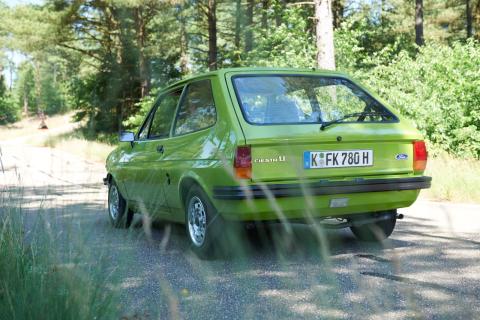
Ford puts an end to the Fiesta after just over 45 years on the market… and becoming an icon both for the brand, for the Valencian plant in Almussafes and for many Spaniards. For this reason, rather than reviewing all the generations here, we focus on highlighting the curiosities that for locals and strangers meant the irruption of this small-great car in the automotive scene.
The first generation of this car today looks like the result of a children’s drawing. But the success of the model would soon go far beyond its forms, due to its good value for money, its spacious interior, useful trunk, its elegant dashboard… and a lot of finishes and engines far from the usual tuning in other rivals. This is the story that nobody has told about the Ford Fiesta.
It has starred in the lives of many Spaniards since its birth until Ford said goodbye to the model after just over 45 years on the market. But it is that, in addition, this compact utility vehicle not only revolutionized the image of the company in Europe, but also marked a before and after in some of the factories where it was produced.
And we have the best example in the Valencian plant in Almussafes. Inaugurated in 1976 by Henry Ford II (yes, the same one who was dismissed by Enzo Ferrari a decade earlier and who led the sporting duel featured in the movie ‘Le Mans 66’) and Juan Carlos de Borbón. There, the one in charge of opening the modern facilities was the Ford Fiesta MKI.
As a first curiosity, we could talk about his name. The prototype, a priori, was very far from adopting such a name, although among the first proposals there were already some in Spanish -or almost-, such as ‘Amigo’, in addition to studying Metro (like Austin), Bolero (it would be a prototype of Seat years later), Tomcat (as the project itself was called), Bebe, Bambi, Cherie, Pony…
‘Fiesta’ was liked due to its universal meaning, a concept that referred to a young, fun car, different from what was among utility vehicles at a time when cars were not divided by segments into much more than large, small and medium. However, although we were still far from the names Titanium, Trend, or ST, we were already thinking about making higher versions…
…for a B-segment that already had an engine -or rather, engines- and performance superior to what was then considered typical of utility vehicles: 957 cc (40/45 hp), and 1,117 cc (53 hp), which would later grow to 1,222 cc (66 hp)… not to mention the 1.3 blocks with 69 and 71 hp, the 1,597 cc with 96 hp and even the 1.6 diesel with 54. And all in box 1 ( including its restyling -1983-89-).
But it is that without going to the Fiesta S -more sporty, with a spoiler and 1.1 engine, even with the so-called ‘Low Compression’ Fiesta BC, the client could opt for a much more modern, powerful, robust and equipped vehicle than some of its rivals , among which were going to be the Seat 127, the Renault 5… and which would later be joined by the Opel Corsa, the Seat Ibiza, the Peugeot 205, the Talbot Horizon, the Citroën AX…
For Ford itself, the Fiesta was its first front-wheel drive car and the first in its catalog to have a three-door hatchback-type body or what we would today call a ‘hatchback’. In addition, it was not often that a manufacturer made its smallest model ‘grow’ up to surnames, finishes and features.
Thus, the party was still pampered with the ‘box 1’ typical of the el que and that, in addition, would soon begin to boast of luxury with the most ‘top’ finish bodied by Guia, in the way that other superior models did. like the Ford Escort, Sierra, Orion… Not to mention that from the first facelift it was ‘gifted’ with the sportier version, under the name of Fiesta XR2i.
Its fame for being ‘more of a car’ than others, due to much more up-to-date colors, equipment and design -some, with a certain extra cost-, made the popular group of the 80s ‘G Men’ baptize it forever as a car for wealthy young people , in his hit ‘Devuélveme a mi chica’ (‘Sufre, sucker’), in whose lyrics “she left with a posh boy, with a white Ford Fiesta and a yellow sweater”.
From 1989 to 1995 (second generation), the mechanical offer was expanded, the surnames of the XR2i (and RS in Great Britain) were kept and it also had access to Zetec engines and the standard airbag for the driver (and optional for the co-pilot). ), as well as the catalytic converter and other elements -such as the ABS, the first in its category- that placed it on the crest of the wave.
In the third generation (1995), the diesel fever gains strength (D and TDdi), diesel and gasoline engines are increasingly more efficient and adjusted to the new and demanding anti-pollution standards; A car without air conditioning is no longer conceived, many limited editions appear… and due to its oval shapes, this Fiesta III is called ‘candy’ inside and outside Ford.
For the next (2002), some glamor is lost with totally new shapes, despite the fact that the Fiesta is no longer Ford’s smallest model (the Ford Ka is already below it). But the competition has come out in his own home from the Puma coupe and his more versatile brother and with the air of a Fusion minivan.
The 2012 generation will be the first that will no longer be manufactured in Almussafes, after 5 million units have left Valencia. The petrol engines range from the economical and award-winning 1.0 EcoBoost to the top-of-the-range 1.6 (ST200), with powers ranging from 60 to 200 hp; the diesels, are divided between the 1.4, 1.5 and 1.6 TDCi (from 68 to 95 CV). Debut in the World Rally Championship, as RS WRC.
end of party
Finally, at AUTO BILD.ES we had the opportunity to see exclusively, long before its launch and from the hands of its designers, the definitive generation of the Ford Fiesta (the brand called it the eighth due to the redesigns), at the end of 2016 …and the first in history to not have vertical taillights (see details at: Ford Fiesta 2017: much more car).
It was a totally new Fiesta inside and out, with new chassis and bodywork, more connected, safe, with attractive colors and Trend, ST Line and ST Line X finishes… and in which in 2020 there would be one last restyling for the also last Fiesta… before losing its three-door version in 2022 and saying goodbye forever after more than 17 million units sold.


























